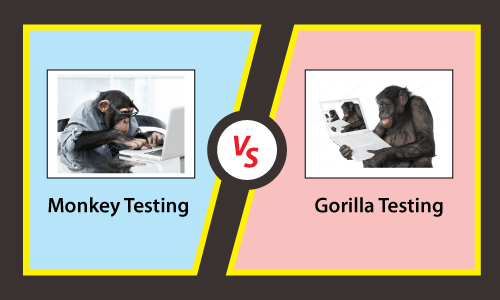In this section, we are going to discuss the difference between Monkey Testing and Gorilla Testing; and see a brief introduction of them.
The two different types of software testing which is known as Monkey Testing and Gorilla Testing. These types of testing are conducted on a piece of software before released in the market.
Before getting into the difference between a monkey and gorilla testing, we will briefly introduce Monkey and Gorilla testing.
What is Monkey Testing?
- In software testing, we have some thorough testings, and Monkey testing is one of them.
- Checking the performance of the software or an application based on some random inputs without any test cases and verifies whether it crashes or not is known as monkey testing.
- It is also known as Fuzz Testing, Random Testing, and Stochastic Testing.
- We cannot use the test case while performing the monkey testing as it is a form of random testing.
- In this testing, an end-user or a test engineer, or a developer can test the system to verify whether it completes the preferred set of actions.
What is Gorilla Testing?
- Another special type of software testing is Gorilla testing.
- Testing all the software modules of an application to its edge is known as Gorilla testing.
- Gorilla testing is also known as Frustrating testing, torture testing, and fault tolerance testing.
- In simple words, we can say that each minor code of the software is tested until it begins to fall separately or fails to provide the preferred outcome.
- To test a module's functionalities constantly the test engineers and developers works together in Gorilla Testing.
Difference between Monkey Testing and Gorilla Testing
We have discussed some significant comparisons between Monkey Testing and Gorilla Testing in the below table.

|
S.NO. |
Monkey Testing |
Gorilla Testing |
|
1. |
In Monkey Testing,
no test case is used to test the application as it is a part of random
testing. |
It is performed
repeatedly as it is a part of manual testing. |
|
2. |
The Monkey Testing
approach is primarily used in System Testing. |
The Gorilla Testing
approach is mainly used in Unit Testing. |
|
3. |
It is a particular
type of Software Testing that is implemented based on specific random inputs
without any test cases and tests the system's performance and validates
whether it fails or not. |
, tests the modules'
functionalities, and validates that no bugs are present in the particular
module. |
|
4. |
It further calls it
Fuzz Testing, Random Testing, and Stochastic Testing. |
It further calls it
Fault Tolerance Testing, Torture Testing, and Frustrating Testing. |
|
5. |
Monkey testing is
implemented on a whole system. |
Gorilla testing is
implemented on few selective components of the system. |
|
6. |
Monkey Testing can
be executed by the end-user, test engineer, and developer in order to test
the system and validate whether it execute the desired set of activities. |
Generally, the
Gorilla Testing is executed by the test engineers and developers either
together or separately in order to check a component's features repeatedly. |
|
7. |
No software
knowledge is required in order to execute the monkey testing. |
It requires minimum
software knowledge in order to execute the gorilla testing. |
|
8. |
The essential
purpose of executing the monkey testing is to test whether the system crashes
or not. |
The fundamental
purpose of executing the gorilla testing is to verify whether the component
or module is working appropriately or not. |
|
9. |
It inhibits the
system failure once the monkey testing is executed. |
On the other hand,
the execution of gorilla testing checks the ability of single module
features. |
|
10. |
Monkey Testing is
divided into three types of testing, namely, Dumb Monkey Testing, Smart
Monkey Testing, and Brilliant Monkey Testing. |
As compared to
monkey testing, gorilla testing did not divide into different types of
testing. |
|
11. |
The implementation
of Monkey testing does not require any planning or preparation. |
The Gorilla testing
cannot implement without any preparation or planning. |
Conclusion
In the above article, we have discussed the critical difference
between Monkey testing and Gorilla testing.
And after seeing all the essential differences, we can conclude
both the testing are the same because of the emphasis on randomly testing a
given software under test.
Therefore, all the possible area is tested in contradiction of
the requirement specifications.
Both the Monkey and Gorilla testing's approaches are action-centered
software testing strategies in order to break the application or the software
under test.
Further, we can say that both Monkey and Gorilla Testing are
other strict and precise testing procedures.



0 Comments